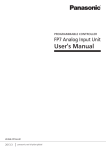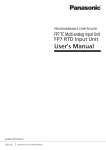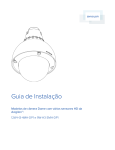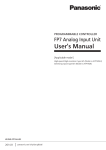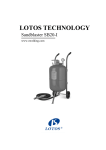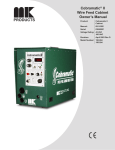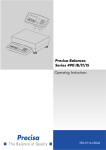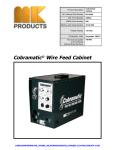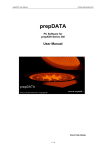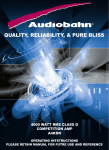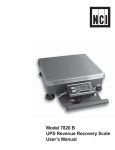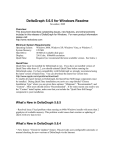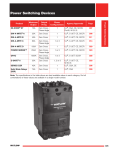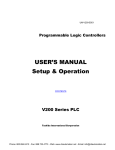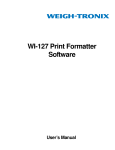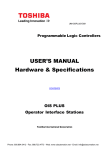Download Panasonic FP7 Analog Input Unit User`s Manual
Transcript
PROGRAMMABLE CONTROLLER FP7 Analog Input Unit User's Manual Phone: 800.894.0412 - Fax: 888.723.4773 - Web: www.ctiautomation.net - Email: [email protected] Safety Precautions Observe the following notices to ensure personal safety or to prevent accidents. To ensure that you use this product correctly, read this User’s Manual thoroughly before use. Make sure that you fully understand the product and information on safety. This manual uses two safety flags to indicate different levels of danger. WARNING If critical situations that could lead to user’s death or serious injury is assumed by mishandling of the product. -Always take precautions to ensure the overall safety of your system, so that the whole system remains safe in the event of failure of this product or other external factor. -Do not use this product in areas with inflammable gas. It could lead to an explosion. -Exposing this product to excessive heat or open flames could cause damage to the lithium battery or other electronic parts. CAUTION If critical situations that could lead to user’s injury or only property damage is assumed by mishandling of the product. -To prevent excessive exothermic heat or smoke generation, use this product at the values less than the maximum of the characteristics and performance that are assured in these specifications. -Do not dismantle or remodel the product. It could cause excessive exothermic heat or smoke generation. -Do not touch the terminal while turning on electricity. It could lead to an electric shock. -Use the external devices to function the emergency stop and interlock circuit. -Connect the wires or connectors securely. The loose connection could cause excessive exothermic heat or smoke generation. -Do not allow foreign matters such as liquid, flammable materials, metals to go into the inside of the product. It could cause excessive exothermic heat or smoke generation. -Do not undertake construction (such as connection and disconnection) while the power supply is on. It could lead to an electric shock. Copyright / Trademarks -This manual and its contents are copyrighted. -You may not copy this manual, in whole or part, without written consent of Panasonic Industrial Devices SUNX Co., Ltd. -Windows is a registered trademark of Microsoft Corporation in the United States and other countries. -All other company names and product names are trademarks or registered trademarks of their respective owners. PLC_ORG Phone: 800.894.0412 - Fax: 888.723.4773 - Web: www.ctiautomation.net - Email: [email protected] Introduction Thank you for buying a Panasonic product. Before you use the product, please carefully read the installation instructions and the users manual, and understand their contents in detail to use the product properly. Types of Manual • There are different types of users manual for the FP7 series, as listed below. Please refer to a relevant manual for the unit and purpose of your use. • The manuals can be downloaded on our website. Unit name or purpose of use Manual name Manual code FP7 Power Supply Unit FP7 CPU Unit Users Manual (Hardware) WUME-FP7CPUH Instructions for Built-in COM Port FP7 Extension (Communication) Cassette FP7 CPU Unit Users Manual (COM Port Communication) WUME- FP7COM Instructions for Built-in LAN Port FP7 CPU Unit Users Manual (LAN Port Communication) WUME-FP7LAN FP7 Digital Input/Output Unit Users Manual WUME-FP7DIO FP7 CPU Unit FP7 Digital Input/Output Unit FP7 Analog Input Unit FP7 Analog Input Unit Users Manual WUME-FP7AIH FP7 Analog Output Unit FP7 Analog Output Unit Users Manual WUME-FP7AOH FP7 Positioning Unit FP7 Positioning Unit Users Manual WUME-FP7POSP PHLS System PHLS System Users Manual WUME-PHLS Programming Software FPWIN GR7 FPWIN GR7 Introduction Guidance WUME-FPWINGR7 Phone: 800.894.0412 - Fax: 888.723.4773 - Web: www.ctiautomation.net - Email: [email protected] Table of Contents Table of Contents 1. Unit Functions and Restrictions........................................ 1-1 1.1 Unit Functions and Operation................................................................. 1-2 1.2 Basic Operation of Analog Input Processing.......................................... 1-3 1.3 Restrictions on Units Combination ......................................................... 1-4 1.3.1 Restriction by Power Consumption .........................................................1-4 2. Names and Functions of Parts .......................................... 2-1 2.1 Analog Input Unit.................................................................................... 2-2 3. Wiring ................................................................................... 3-1 3.1 Wiring of Terminal Block ........................................................................ 3-2 3.2 Connecting Analog Input ........................................................................ 3-3 3.3 3.2.1 Voltage Input (-10 to +10, 0 to +10, 0 to +5, and +1 to +5 V) ................3-3 3.2.2 Current Input (0 to +20, +4 to +20 mA) ...................................................3-4 Connecting Trigger Input Terminal TRIG ............................................... 3-5 4. Unit Settings and data Reading ......................................... 4-1 4.1 4.2 Confirming the I/O Number Allocations and First Word Number............ 4-2 4.1.1 Occupied I/O Area and I/O Allocations ...................................................4-2 4.1.2 Confirming the I/O Number Allocations...................................................4-4 Option settings ....................................................................................... 4-5 4.2.1 Configuration of Analog Input unit...........................................................4-5 Phone: 800.894.0412 - Fax: 888.723.4773 - Web: www.ctiautomation.net - Email: [email protected] ii Table of Contents 4.2.2 4.3 Reading Analog Input Data..................................................................... 4-8 4.3.1 4.4 Unit Setting and Conversion Processing Time .......................................4-7 Reading Analog Input Data .....................................................................4-8 Data Acquisition Timing .......................................................................... 4-9 5. Conversion Characteristics of Analog Input Unit ............5-1 5.1 5.2 Voltage Range ........................................................................................ 5-2 5.1.1 Voltage Input Range: -10 to +10 V (0.32 mV, 1/62,500).........................5-2 5.1.2 Voltage Input Range: 0 to +10 V (0.32 mV, 1/31,250)............................5-3 5.1.3 Voltage Input Range: 0 to +5 V (0.16 mV, 1/31,250)..............................5-3 5.1.4 Voltage input range: 1 to 5 V (0.16 mV, 1/25,000)..................................5-4 Current Range ........................................................................................ 5-5 5.2.1 Current Input Range: 0 to +20 mA (0.64μA, 1/31,250) ...........................5-5 5.2.2 Current Input Range: +4 to +20 mA (0.64μA, 1/25,000).........................5-5 6. Optional Settings for Analog Input ....................................6-1 6.1 Average Processing Settings.................................................................. 6-2 6.1.1 Number of Averaging Times ...................................................................6-2 6.1.2 Time Average ..........................................................................................6-3 6.1.3 Moving Average ......................................................................................6-4 6.2 Offset/Gain processing ........................................................................... 6-5 6.3 Scale Conversion.................................................................................... 6-7 6.4 Comparison for Upper and Lower Limits ................................................ 6-8 6.5 Holding Max./Min. Values ..................................................................... 6-11 6.6 Disconnection detection........................................................................ 6-14 6.7 Buffer Settings ...................................................................................... 6-16 6.7.1 Overview of Buffer Function..................................................................6-16 6.7.2 Buffering by Trigger Output Relay.........................................................6-18 Phone: 800.894.0412 - Fax: 888.723.4773 - Web: www.ctiautomation.net - Email: [email protected] iii Table of Contents 6.8 6.7.3 Buffering by External Input Trigger .......................................................6-20 6.7.4 Buffering Triggered by Value Change in Analog Input..........................6-22 Configuration by Programming............................................................. 6-24 7. What to Do If an Error Occurs............................................ 7-1 7.1 What to Do If an Error Occurs (Analog Input) ........................................ 7-2 7.1.1 Failure in Reading Analog Input Data .....................................................7-2 7.1.2 Unstable Analog Input Conversion Value ...............................................7-2 7.1.3 No Proper Conversion Values Obtained with Current Input ...................7-2 8. Specifications...................................................................... 8-1 8.1 Specifications ......................................................................................... 8-2 8.2 I/O Allocation .......................................................................................... 8-4 8.3 List of Unit Memories.............................................................................. 8-6 8.3.1 List of Unit Memory Number....................................................................8-6 8.4 List of Detailed Specifications of Unit Memories .................................... 8-7 8.5 Dimensions........................................................................................... 8-11 Phone: 800.894.0412 - Fax: 888.723.4773 - Web: www.ctiautomation.net - Email: [email protected] iv 1 Unit Functions and Restrictions Phone: 800.894.0412 - Fax: 888.723.4773 - Web: www.ctiautomation.net - Email: [email protected] Unit Functions and Restrictions 1.1 Unit Functions and Operation Features of analog input unit The analog input unit receives various analog values (i.e., voltage, current, and temperature values) from laser analog sensors and pressure sensors and converts them internally into digital values. • The analog input unit can receive input through a number of channels. Analog input units: 4 channels Six types of input ranges can be selected to support a variety of connecting equipment. • The speed of conversion, such as voltage/current range conversion, is as high as 25 μs/channel (non-isolated). • Converts input analog values into digital data with up to 16 bits in a resolution range of 1/25,000 to 1/62,500. Phone: 800.894.0412 - Fax: 888.723.4773 - Web: www.ctiautomation.net - Email: [email protected] 1-2 1.2 Basic Operation of Analog Input Processing 1.2 Basic Operation of Analog Input Processing Analog input is processed as explained below. Operation of analog input unit (1) Receiving analog input The analog input unit receives analog input data from analog devices, such as laser analog sensors and pressure sensors. (2) Digital conversion processing Analog input data received by the unit is converted into digital values in sequence automatically. (3) Storage of digital values A user program is used to read converted digital values as data in the input relay area (WX). (3) (2) (1) V or I t Option setting The following option setting functions are provided for analog input processing. Any of the option setting functions can be set by writing the function to the unit memory (UM) by using the configuration menu of the FPWIN GR7 or a user program. • Average processing (number of times, time average, and moving average) • Scale conversion • Offset/Gain processing • Holding Max./Min. • Comparison for upper and lower limits • Disconnection detection • Buffering Phone: 800.894.0412 - Fax: 888.723.4773 - Web: www.ctiautomation.net - Email: [email protected] 1-3 Unit Functions and Restrictions 1.3 Restrictions on Units Combination 1.3.1 Restriction by Power Consumption The unit has the following internal current consumption. Make sure that the total current consumption is within the capacity of the power supply with consideration of all other units used in combination with the analog input unit. Name Product no. Current consumption FP7 analog input unit AFP7AD4H 100 mA or less Phone: 800.894.0412 - Fax: 888.723.4773 - Web: www.ctiautomation.net - Email: [email protected] 1-4 2 Names and Functions of Parts Phone: 800.894.0412 - Fax: 888.723.4773 - Web: www.ctiautomation.net - Email: [email protected] Names and Functions of Parts 2.1 Analog Input Unit Names and functions of parts (1) Operation monitor LEDs LED name LED color Contents - Blue Lit when the CPU unit is turned ON. ERROR Red Lit if the configuration settings are beyond the allowable range or A/D conversion is not possible. ALARM Red Lit if the hardware has an error. (2) Terminal block release lever To remove the analog input terminal block, push the release lever downward. (3) DIN rail attachment lever This lever is used to fix the unit to the DIN rail. (4) Unit Connector Connects to other I/O units and high-function units. (5) Analog input terminal block The terminal block is removable. Remove the terminal block before wiring. Solderless terminals for M3 can be used. (8) Fixing hook Used to secure the unit with another unit. Phone: 800.894.0412 - Fax: 888.723.4773 - Web: www.ctiautomation.net - Email: [email protected] 2-2 3 Wiring Phone: 800.894.0412 - Fax: 888.723.4773 - Web: www.ctiautomation.net - Email: [email protected] Wiring 3.1 Wiring of Terminal Block Suitable solderless terminals/wires M3 terminal screws are used for the terminal. The following suitable solderless terminals are recommended for the wiring to the terminals • Suitable solderless terminals Manufacturer Shape Part no. Suitable wires 1.25-MS3 1.25-B3A 2-MS3 2-N3A 0.25 to 1.65 mm 2 J.S.T. Mfg Co., Ltd. Round type Fork type Round type Fork type 1.04 to 2.63 mm 2 • Suitable wires Suitable wires 2 Tightening torque 2 AWG22 to 14 (0.3 mm to 2.0 mm ) 0.5 to 0.6N ·m Connection to the terminal block Remove the terminal block before beginning the wiring operations. To remove the terminal block, push the release lever located at the top of the terminal block downward. Lock button <Bottom of unit> NOTE Install the terminal block by inserting it all the way to its original position and pressing the lock button on the bottom of the unit. Then confirm that the terminal block is securely attached and cannot be removed. Phone: 800.894.0412 - Fax: 888.723.4773 - Web: www.ctiautomation.net - Email: [email protected] 3-2 3.2 Connecting Analog Input 3.2 Connecting Analog Input 3.2.1 Voltage Input (-10 to +10, 0 to +10, 0 to +5, and +1 to +5 V) Wiring diagram and internal circuit diagram Terminal layout Phone: 800.894.0412 - Fax: 888.723.4773 - Web: www.ctiautomation.net - Email: [email protected] 3-3 Wiring 3.2.2 Current Input (0 to +20, +4 to +20 mA) Wiring diagram and internal circuit diagram In the case of current input, connect the Vn and In terminals. Terminal layout NOTES • Use double-core twisted-pair shielded wires. It is recommended to ground them. However, depending on the conditions of the external noise, it may be better not to ground the shielding. • Do not place the analog input wiring close to AC lines, high-tension lines, or load lines other than PLC wires or bundle the analog input and other wires together. Phone: 800.894.0412 - Fax: 888.723.4773 - Web: www.ctiautomation.net - Email: [email protected] 3-4 3.3 Connecting Trigger Input Terminal TRIG 3.3 Connecting Trigger Input Terminal TRIG The trigger input terminal is used when the buffer function is used with an external input signal as a trigger signal. This terminal needs not be connected if these functions are not used. Description Items Description Insulation system Optical coupler Rated input voltage 24 V DC Rated input current Approx. 4.5 mA (at 24 V) Input impedance Approx. 5.1kΩ Operating voltage range 21.6 to 26.4 V DC Min. ON voltage/Min. ON current 19.2 V/3.5 mA Max. OFF voltage/Max. OFF current 5 V/1.5 mA Response time OFF→ON 0.2 ms or less ON→OFF 0.2 ms or less Input points per common 2 point/1 common External connection method Terminal block connections (M3 terminal screws) Internal circuit diagram Terminal layout TRIG terminal 910 Ω Internal circuit 24 V DC T-COM terminal 5.1 kΩ Phone: 800.894.0412 - Fax: 888.723.4773 - Web: www.ctiautomation.net - Email: [email protected] 3-5 Wiring Phone: 800.894.0412 - Fax: 888.723.4773 - Web: www.ctiautomation.net - Email: [email protected] 3-6 4 Unit Settings and data Reading Phone: 800.894.0412 - Fax: 888.723.4773 - Web: www.ctiautomation.net - Email: [email protected] Unit Settings and data Reading 4.1 Confirming the I/O Number Allocations and First Word Number 4.1.1 Occupied I/O Area and I/O Allocations In the FP7, analog input data is allocated to the external input relay area and processed. An analog input signal into a single channel is handled by 16 X-contact points. The following table shows the I/O allocation of analog input data. Input contact I/O number CH0 CH1 CH2 CH3 Name Description Digital converted values corresponding to the analog input is stored. <Voltage range> X40 to X4F WX6 X20 to X2F WX4 X0 to XF WX2 WX0 -10 to +10 V: -31,250 to +31,250 X60 to X6F A/D conversion data (16 bits) 0 to +10 V or 0 to +5 V: 0 to +31,250 +1 to +5 V: 0 to +25,000 <Current range> 0 to +20 mA: 0 to +31,250 +4 to +20 mA: 0 to +25,000 X50 X70 Disconnection detection flag ON with disconnection detected and OFF with disconnection restored (valid for 1 to 5 V and 4 to 20 mA ranges only) X11 X31 X51 X71 Upper limit comparison relay Turns ON when the value exceeds the set upper limit. X12 X32 X52 X72 Lower limit comparison relay Turns ON when the value drops below the set lower limit. X13 X33 X53 X73 Upper limit/Lower limit comparison execution flag ON when the upper limit/lower limit comparison function is executed. X14 X34 X54 X74 Not used Do not use. X15 X35 X55 X75 Max./Min. hold execution flag ON when the max./min. hold function is executed. X76 X77 Not used Do not use. Buffer function execution flag ON when the buffer function is executed. X16 X17 X18 X36 X37 - X56 X57 - WX7 X30 WX5 X10 WX3 WX1 * A/D conversion data within the set scale applies if scale conversion is set. - X19 - - - Buffering flag ON when buffering starts after the trigger is accepted. OFF when the number of buffer data items is reached. X1A - - - Buffering completion flag ON when the shared memory has become accessible after completion of buffering OFF on completion of buffer data reading. X1B - - - Data before triggering enable flag ON when the number of buffer data items before triggering has reached the set value. OFF on completion of buffer data reading. Phone: 800.894.0412 - Fax: 888.723.4773 - Web: www.ctiautomation.net - Email: [email protected] 4-2 4.1 Confirming the I/O Number Allocations and First Word Number X1C to X1E X3C to X3E X5C to X5E X7C to X7E Not used Do not use. X1F X3F X5F X7F Error flag Turns ON if an error occurs. (Note 1) The I/O numbers in the tables above show offset addresses. I/O numbers actually allocated are based on the first word number allocated to the unit. (Example) If the first word number is 10, the D/A conversion data on CH0 and the error flag will be WX10 and X11F, respectively. (Note 2): The conditions of the buffer function (i.e., the buffer function execution flag, buffering flag, buffering completion flag, and data enable flag before triggering) are allocated to the input contacts for CH0. Output contact I/O number CH1 CH2 CH3 Name Description ON to execute the disconnection detection function. OFF to turn OFF the disconnection detection flag (Xn0). (valid for 1 to 5 V and 4 to 20 mA ranges only) Y0 Y10 Y20 Y30 Disconnection detection execution relay Y1 Y2 Y11 Y12 Y21 Y22 Y31 Y32 Not used Do not use. ON to execute the function to compare the upper and lower limits. OFF to turn OFF the upper limit comparison relay (Xn1) and lower limit comparison relay (Xn2). Y3 Y13 Y23 Y33 Upper limit/Lower limit comparison execution relay Y4 Y14 Y24 Y34 Not used Do not use. ON when the max./min. hold function is executed. Y25 Y35 Y6 Y7 Y16 Y17 Y26 Y27 Y36 Y37 Not used Do not use. WY3 Y15 WY2 Y5 Max./Min. hold execution relay WY1 WY0 CH0 Y8 - - - Buffer execution relay When the buffer function is enabled, trigger acceptance will be permitted with the buffer execution relay turned ON. The internal state transition will be initialized with the buffer execution relay turned OFF. Y9 - - - Buffer trigger relay If “Trigger relay” is set in trigger setting, triggering will start with the trigger relay turned ON. Buffer data Read completion relay ON upon completion of reading buffer data from the shared memory. Goes to the state of trigger acceptance permitted after clearing the buffer memory. YA - - - YB to YE Y1B to Y1E Y2B to Y2E Y3B to Y3E Not used Do not use. YF Y1F Y2F Y3F Error flag reset relay Reset the error flag. (Note 1) The I/O numbers in the tables above show offset addresses. I/O numbers actually allocated are based on the first word number allocated to the unit. (Example) If the first word number is 10, the disconnection detection execution relay on CH0 and the error flag reset relay will be Y100 and X10F, respectively. (Note 2) The operation of the buffer function (consisting of the buffer execution relay, buffer trigger relay, and buffer data read completion relay) is specified by the output contacts for CH0. Phone: 800.894.0412 - Fax: 888.723.4773 - Web: www.ctiautomation.net - Email: [email protected] 4-3 Unit Settings and data Reading 4.1.2 Confirming the I/O Number Allocations • I/O numbers and base word numbers are always necessary when writing programs. Always check to see if the numbers match the design. • I/O numbers allocated to the analog input unit are determined by the first word number. Allocations to unit Take the following procedure to set the first word number. PROCEDURE 1. Select “Options” → “FP7 Configuration” from the menu bar. 2. Select “I/O Map” from the field. 3. Double-click the target slot where the operating unit is to be inserted. 4. Select “Analog I/O” and “Input Unit” in the unit selection field. 5. Press the [OK] button. The first word number specified is set. Phone: 800.894.0412 - Fax: 888.723.4773 - Web: www.ctiautomation.net - Email: [email protected] 4-4 4.2 Option settings 4.2 Option settings 4.2.1 Configuration of Analog Input unit Use the FPWIN GR7 configuration menu to make analog input unit settings, such as input range and isolation/non-isolation settings. Setting method The following steps are described on the condition that the analog input unit has been already allocated on the I/O map. PROCEDURE 1. Select “Options” → “FP7 Configuration” from the menu bar. 2. Select “I/O Map” from the field 3. Select the slot where the analog input unit is registered and press the [Advanced] button. The “Analog unit settings” dialog box is displayed. 4. Select the isolation, conversion process skip, and input range settings. Select option setting as required. 5. Press the [OK] button. The set value will become effective when the set value is downloaded together with a corresponding program as a project. Phone: 800.894.0412 - Fax: 888.723.4773 - Web: www.ctiautomation.net - Email: [email protected] 4-5 Unit Settings and data Reading Settings Group Basic setting items (common to all channels) Basic setting items (per channel) Option setting items (per channel) Setting item Settings Default Isolation between channels Non-isolated/Isolated Non-isolated Buffer function Not use/Use Not use Trigger type Trigger input relay/rise of external input trigger/fall of external input trigger/rising time of analog input level/falling time of analog input level Trigger input relay External input trigger Unused/TRIG0/TRIG1/TRIG2/TRIG3 Not used Input level trigger CH Unused/CH0/CH1/CH2/CH3 Not used No. of buffer data items 1 to 10,000 1000 No. of data items before triggering 0 to 9,999 0 Trigger cycle 1 to 30,000 1 Analog input trigger level -31,250 to +31,250 0 Conversion processing Execute/Not execute Execute Range setting -10 to +10 V 0 to +10 V 0 to +5 V +1 to +5 V 0 to +20 mA +4 to +20 mA -10 to +10 V Average processing settings Not execute/No. of averaging times/time average/moving average Not execute Offset/Gain processing Not execute/Execute Not execute Scale conversion Not execute/Execute Not execute Comparison settings for upper and lower limits Not execute/Execute Not execute Max./Min. Not execute/Execute Not execute Disconnection detection settings Not execute/Execute Not execute Disconnection detection reset Auto/Manual Auto Averaging constant Times: 2 to 60,000 [times] Time (non-isolated): 1 to 1,500 [ms] Time (isolated): 200 to 60,000 [ms] Moviing average: 2 to 2,000 [times] 200 Offset value -3,000 to +3,000 0 Gain value +9,000 to +11,000 +10,000 Scale conversion max. value -30,000 to +30,000 10,000 Scale conversion min. value -30,000 to +30,000 0 Upper limit comparison ON level -31,250 to +31,250 0 Upper limit comparison OFF level -31,250 to +31,250 0 Lower limit comparison ON level -31,250 to +31,250 0 Lower limit comparison OFF level -31,250 to +31,250 0 Phone: 800.894.0412 - Fax: 888.723.4773 - Web: www.ctiautomation.net - Email: [email protected] 4-6 4.2 Option settings 4.2.2 Unit Setting and Conversion Processing Time Conversion time varies with the configuration setting conditions. Isolation setting and conversion processing time • Isolated: 5 ms/ch • Non-isolated: 25 μs/ch • The speed of A/D conversion processing will become faster if non-isolation is set. Each channel is isolated by switching the respective photo-MOS relays of the channels at the time of conversion. The photo-MOS relays are always turned ON at the time of non-isolation and the commons will be shared. Conversion processing execution/non-execution setting and conversion processing time Select the execution or non-execution of the conversion processing of analog input on a channel-by-channel basis. This can save the conversion time for channels that do not execute conversion processing. Example) Conversion time for four channels Converted in the order of ch0→ch1→ch2→ch3→ch0→ch1→ch2→ch3→.... (1 cycle = 100 μs at the time of non-isolation) Example) Conversion time for two channels (with CH2 and CH3 excluded). Conversion is executed in the order of ch0→ch1→ch0→ch1→ch0→ch1→ch0→ch1→... and the conversion time for CH2 and CH3, which are excluded, is saved. (1 cycle = 50 μs at the time of non-isolation) Phone: 800.894.0412 - Fax: 888.723.4773 - Web: www.ctiautomation.net - Email: [email protected] 4-7 Unit Settings and data Reading 4.3 Reading Analog Input Data 4.3.1 Reading Analog Input Data Basic Operation of Analog Input Processing (1) Receiving analog input The analog input unit receives analog input data from devices, such as laser analog sensors and pressure sensors. (2) Digital conversion processing Analog input data received by the unit is converted into digital values in sequence automatically in the unit. The converted digital value varies with the setting of the range. (3) Storage of digital values A user program is used to read converted digital values as data in the input relay area (WX). The specified area number varies depending on the installation position of the unit. (3) (2) (1) V or I t Program to Acquire Converted Digital Values Reading the values in digital conversion value storage areas WX10, WX12, WX14, and WX16 to any a reas of data registers ranging from DT100 to DT103. R0 MV.SS WX10 CH0 input DT100 MV.SS WX12 CH1 input DT101 MV.SS WX14 CH2 input DT102 MV.SS WX16 CH3 input DT103 Transferring the digital data in analog input areas WX10, WX12, WX14, and WX16 to data registers ranging from DT100 to DT103. Phone: 800.894.0412 - Fax: 888.723.4773 - Web: www.ctiautomation.net - Email: [email protected] 4-8 4.4 Data Acquisition Timing 4.4 Data Acquisition Timing Input conversion processing time of analog input unit Conversion processing time varies with the range and the number of channels in use. The conversion execution/non-execution channel function can save the conversion time for channels that do not execute conversion processing. z Example of 2-channel conversion Converted in the order of ch0→ch1→ch0→ch1→.... Data acquisition timing of CPU unit • Digital values converted by the analog input unit are input into the CPU unit at the I/O refreshing timing of the CPU unit. • The conversion processing of the analog input unit is not synchronized with the I/O refreshing timing of the CPU unit. Therefore, the latest data is input into the operation memory of the CPU unit when the CPU unit implements I/O refreshing. • Example of 4-channel conversion b c a d e Analog signal of ch0 Converts in the order of ch0→ch1→ch2→ch3 Processing in the analog input part 0 1 2 3 0 1 2 3 0 1 2 3 0 1 2 3 0 I/O refresh Processing in the CPU unit Data of ch0 to be read in the CPU unit a b c d Phone: 800.894.0412 - Fax: 888.723.4773 - Web: www.ctiautomation.net - Email: [email protected] 4-9 Unit Settings and data Reading • Example of 1-channel conversion Analog signal of ch0 a c b e d f g h i j k l m n o p q r Converts ch0 repeatedly Processing in the analog input part I/O refresh Processing in the CPU unit Data of ch0 to be read in the CPU unit a c e g j l n p Phone: 800.894.0412 - Fax: 888.723.4773 - Web: www.ctiautomation.net - Email: [email protected] 4-10 5 Conversion Characteristics of Analog Input Unit Phone: 800.894.0412 - Fax: 888.723.4773 - Web: www.ctiautomation.net - Email: [email protected] Conversion Characteristics of Analog Input Unit 5.1 Voltage Range 5.1.1 Voltage Input Range: -10 to +10 V (0.32 mV, 1/62,500) Input range: -10 to +10 V Analog input value (V) Digital conveted value (K) +10 +8 +6 +4 +2 0 -2 -4 -6 -8 -10 +31,250 +25,000 +18,750 +12,500 +6,250 0 -6,250 -12,500 -18,750 -25,000 -31,250 When exceeding the rated range Analog input value Converted value +10 V or more -10V or less +31,250 -31,250 Phone: 800.894.0412 - Fax: 888.723.4773 - Web: www.ctiautomation.net - Email: [email protected] 5-2 5.1 Voltage Range 5.1.2 Voltage Input Range: 0 to +10 V (0.32 mV, 1/31,250) Input range: 0 to +10 V Analog input value (V) Digital conveted value (K) +10 +8 +6 +4 +2 0 +31,250 +25,000 +18,750 +12,500 +6,250 0 When exceeding the rated range Analog input value Converted value +10 V or more 0 V or less +31,250 0 5.1.3 Voltage Input Range: 0 to +5 V (0.16 mV, 1/31,250) Input range: 0 to +5 V Analog input value (V) Digital conveted value (K) +5 +4 +3 +2 +1 0 +31,250 +25,000 +18,750 +12,500 +6,250 0 When exceeding the rated range Analog input value Converted value +5 V or more 0 V or less +31,250 0 Phone: 800.894.0412 - Fax: 888.723.4773 - Web: www.ctiautomation.net - Email: [email protected] 5-3 Conversion Characteristics of Analog Input Unit 5.1.4 Voltage input range: 1 to 5 V (0.16 mV, 1/25,000) Input range: 1 to 5 V Analog input value (V) Digital conveted value (K) 5 4 3 2 1 25,000 18,750 12,500 6,250 0 When exceeding the rated range Analog input value Converted value 5 V or more 1 V or less 25,000 0 Phone: 800.894.0412 - Fax: 888.723.4773 - Web: www.ctiautomation.net - Email: [email protected] 5-4 5.2 Current Range 5.2 Current Range 5.2.1 Current Input Range: 0 to +20 mA (0.64μA, 1/31,250) Input range: 0 to +20 mA Analog input value (mA) Digital conveted value (K) +20 +16 +12 +8 +4 0 +31,250 +25,000 +18,750 +12,500 +6,250 0 When exceeding the rated range Analog input value Converted value +20 mA or more 0 mA or less +31,250 0 5.2.2 Current Input Range: +4 to +20 mA (0.64μA, 1/25,000) Input range: +4 to +20 mA Analog input value (mA) Digital conveted value (K) +20 +16 +12 +8 +4 +25,000 +18,750 +12,500 +6,250 0 When exceeding the rated range Analog input value Converted value +20 mA or more +4 mA or less +25,000 0 Phone: 800.894.0412 - Fax: 888.723.4773 - Web: www.ctiautomation.net - Email: [email protected] 5-5 Conversion Characteristics of Analog Input Unit Phone: 800.894.0412 - Fax: 888.723.4773 - Web: www.ctiautomation.net - Email: [email protected] 5-6 6 Optional Settings for Analog Input Phone: 800.894.0412 - Fax: 888.723.4773 - Web: www.ctiautomation.net - Email: [email protected] Optional Settings for Analog Input 6.1 Average Processing Settings 6.1.1 Number of Averaging Times Overview of functions • Analog input data sampled by the unit is averaged and stored as digital values. • If the number of averaging times is set, analog input data items acquired will be stored as digital values when the number of analog input data items reaches the set number of averaging times. • If the number of data items acquired is less than the number of averaging times, the acquired data will be stored in the I/O area. • Obtain the number of averaging times to be processed from the following input. Input: The sum of analog input data items for the number of averaging times Output: Number of averaging times value Processing during the number of averaging times Averaging setting example: The number of averaging times is set to 5. c e d f g o h b a q r n i j Analog signal p m k l Analog input processing Average of a to e Average of f to j Average of k to o Analog input data Configuration Name Function setting Default Setting range and description Average processing settings Not execute Select “the number of averaging times.” Averaging constant K200 Number: 2 to 60,000 [times] (specified with an unsigned integer) Phone: 800.894.0412 - Fax: 888.723.4773 - Web: www.ctiautomation.net - Email: [email protected] 6-2 6.1 Average Processing Settings 6.1.2 Time Average Overview of functions • Analog input data sampled by the unit is averaged and stored as digital values. • If time average is set, analog input data items acquired will be stored as digital values when the acquisition period of the analog input data items reaches the set averaging time. • Obtain the time average to be processed from the following input. Input: The sum of analog input data items for the number of averaging time Output: Time average value Processing during time average Average setting example: Example of an averaging time of 5 ms Elapse of 5 ms Elapse of 5 ms C0 An A2 B0 A1 C2 Bn B1 A0 C1 B2 Analog signal Analog input processing ・・・・・ ・・・・・ ・・・・・ ・・・・・ ・・・・・ ・・・・・ Average of A0 to An Average of B0 to Bn Analog input data Configuration Name Function setting Default Setting range and description Average processing settings Not execute Select “time average.” Averaging constant K200 Time (non-isolated): 1 to 1,500 [ms] Time (isolated): 200 to 60,000 [ms] (Specified with an unsigned integer) Phone: 800.894.0412 - Fax: 888.723.4773 - Web: www.ctiautomation.net - Email: [email protected] 6-3 Optional Settings for Analog Input 6.1.3 Moving Average Overview of functions • Analog input data sampled by the unit is averaged and stored as digital values. • If moving average is set, analog input data items acquired will be stored as digital values when the number of analog input data items reaches the set number of moving average times. • Obtain the number of averaging times to be processed from the following input. Input: The number of average times, analog input data for the number of average times, the latest analog input data, and old analog input data Output: Moving average value Processing during moving average Averaging setting example: The number of averaging times is set to 15. c d e f g o h b a p n i j Analog signal q r m k l ・・・ Average of a to o Average of b to p Analog input processing Average of c to q Analog input data ・・・ ・・・ Configuration Name Function setting Default Setting range and description Average processing settings Not execute Select “moving average.” Averaging constant K200 Number: 2 to 2,000 [times] (specified with an unsigned integer) Phone: 800.894.0412 - Fax: 888.723.4773 - Web: www.ctiautomation.net - Email: [email protected] 6-4 6.2 Offset/Gain processing 6.2 Offset/Gain processing Overview of Functions • Offset value (added correction) and gain value (magnification correction) adjustments are made to store processed data in the I/O area. Analog input data Offset processing Gain processing Analog postprocessing data • Offset value settings are used as a function (zero-point adjustment) to make offset error adjustments between load devices. If the analog conversion value is K50 when the analog input value is 0 V, the analog conversion data is corrected to 0 V based on K-50 as an offset value. (K) (K) 50 (V) (V) Offset processing • Gain value settings are used as a function to adjust delicate scale errors between load devices. The gain value slope can be changed in a range of x0.9 to x1.1. (K) (K) Gain x 1.1 Gain x 0.9 (V) (V) Gain processing • Offset/Gain processing is executed on a channel-by-channel basis. Phone: 800.894.0412 - Fax: 888.723.4773 - Web: www.ctiautomation.net - Email: [email protected] 6-5 Optional Settings for Analog Input Configuration Name Default Setting range and description Not execute Select “Execute.” Offset value K0 Set an offset value at the time of using the offset processing function. Gain value K10,000 Set an gain value at the time of using the gain processing function. Function setting Offset/Gain processing Setting range: -3,000 to +3,000 (specified with a signed integer) Setting range: +9,000 to 1+1,000 (0.9x to 1.1x: Specified with a signed integer) NOTE The offset value is corrected to a value corresponding to the resolution of the input range of the original value regardless of whether scale conversion is set or not. Phone: 800.894.0412 - Fax: 888.723.4773 - Web: www.ctiautomation.net - Email: [email protected] 6-6 6.3 Scale Conversion 6.3 Scale Conversion Overview of functions • This function makes it possible to set an easy-to-use analog output range. Analog input data acquired in a range between preset minimum and maximum values is scale converted and stored in the I/O area. This function is convenient if used for scale unit conversion. • Scale conversion is executed on a channel-by-channel basis. • Conversion values read from the analog input unit include fractions. Therefore, convert the values to easy-to-handle figures if needed. (K) (K) 25000 10000 12500 Scale conversion 1 3 5 (V) 5000 1 3 5 (V) Configuration Name Default Setting range and description Not execute Select “Execute.” Minimum value of scale conversion K0 Set the minimum value at the time of using the scale conversion function. Maximum value of scale conversion K10,000 Function setting Scale conversion Setting range: -30,000 to +30,000 (specified with a signed integer) Set the maximum value at the time of using the scale conversion function. Setting range: -30,000 to +30,000 (specified with a signed integer) * If data outside the minimum or maximum scale is input, scale conversion will be disabled and the minimum or maximum scale value will be stored as a conversion value. Phone: 800.894.0412 - Fax: 888.723.4773 - Web: www.ctiautomation.net - Email: [email protected] 6-7 Optional Settings for Analog Input 6.4 Comparison for Upper and Lower Limits Overview of Functions This function compares acquired data with the upper limit and lower limit and turns ON the upper limit relay or lower limit relay if the acquired data exceeds the upper limit value or lower limit value. • Comparison for upper and lower limits is executed on a channel-by-channel basis. • The upper limit relay will turn ON if the digital conversion value is larger than the upper limit. • The lower limit relay will turn ON if the digital conversion value is smaller than the lower limit. • The function will be disabled with the comparison execution relay (Y) turned ON if the configuration-upper/lower limit comparison setting is not executed. (K) Upper limit comparison ON level (2) Upper limit comparison OFF level (3) Lower limit comparison OFF level Digital converted value Lower limit comparison ON level (4) (Flag) Comparison execution relay (*1) Upper limit comparison relay (*1) (1) (5) Lower limit comparison relay (*3) Comparison execution flag (*4 ) (t) (1) The upper/lower limit comparison function will be executed when the user program turns ON the comparison execution relay. (2) The upper limit comparison relay will turn ON if the upper limit comparison ON level or an upper level is detected (3) The upper limit comparison relay will turn OFF if the upper limit comparison OFF level or a lower level is detected. (4) The lower limit comparison relay will turn ON if the lower limit comparison ON level or a lower level is detected. (5) The upper/lower limit comparison relay and comparison execution flag will be forcibly turned OFF if the comparison execution relay is turned OFF. Phone: 800.894.0412 - Fax: 888.723.4773 - Web: www.ctiautomation.net - Email: [email protected] 6-8 6.4 Comparison for Upper and Lower Limits I/O Allocation The I/O numbers in the timing chart and program are shown on the condition that the first word number of the unit is 10. Actual I/O numbers allocated to the analog input unit are determined by the first word number. CH0 CH1 CH2 CH3 *1 Comparison execution relay Y103 Y113 Y123 Y133 *2 Upper limit comparison relay X111 X131 X151 X171 *3 Lower limit comparison relay X112 X132 X152 X172 *4 Comparison execution flag X113 X133 X153 X173 Configuration Name Default Setting range and description Not execute Select the desired function to be used. Upper/Lower limit comparison Upper limit comparison ON level K0 Set the upper limit to turn ON the output flag at the time of using the upper/lower limit comparison function. Upper/Lower limit comparison Upper limit comparison OFF level K0 Set the upper limit to turn OFF the output flag at the time of using the upper/lower limit comparison function. Upper/Lower limit comparison Lower limit comparison OFF level K0 Set the lower limit to turn OFF the output flag at the time of using the upper/lower limit comparison function. Upper/Lower limit comparison Lower limit comparison ON level K0 Set the lower limit to turn ON the output flag at the time of using the upper/lower limit comparison function. Function setting Upper limit / Lower limit comparison Setting range: -31,250 to +31,250 (specified with a signed integer) Setting range: -31,250 to +31,250 (specified with a signed integer) Setting range: -31,250 to +31,250 (specified with a signed integer) Setting range: -31,250 to +31,250 (specified with a signed integer) (Note) Make the following level settings for upper/lower limit comparison. Lower limit comparison ON level ≤ Lower limit comparison OFF level < Upper limit comparison OFF level ≤ Upper limit comparison ON level Phone: 800.894.0412 - Fax: 888.723.4773 - Web: www.ctiautomation.net - Email: [email protected] 6-9 Optional Settings for Analog Input Sample Program The digital conversion value on ch0 of the analog input unit is read to detect the upper limit and lower limit, and the desired output is turned ON with the upper or lower limit detected. R0 ( DF ) R1 ( DF ) X113 X111 Comparison Upper limit execution comparison flag relay X113 X112 Comparison Lower limit execution comparison flag relay Y103 < SET > (CH0): Upper/Lower limit comparison execution relay Y103 < RST > (CH0): Upper/Lower limit comparison execution relay Y200 Y201 (CH0): Controls upper and lower limit comparison function R0 ON: Comparison execution R1 ON: Turns OFF comparison execution relay. (CH0): Turns ON Y200 when the value exceeds the upper limit. (CH0): Turns ON Y201 when the value drops below the lower limit. Phone: 800.894.0412 - Fax: 888.723.4773 - Web: www.ctiautomation.net - Email: [email protected] 6-10 6.5 Holding Max./Min. Values 6.5 Holding Max./Min. Values Overview of Functions This function maintains the maximum and minimum values of acquired data. When the maximum and minimum value hold settings are valid, the maximum and minimum digital conversion values will be maintained and stored in the following unit memories. • If the function has not been enabled with the configuration settings, the function will not work with the hold execution relay turned ON. • When the hold execution relay is turned ON, the values at that time will be preset as maximum and minimum values in the unit memories. • The maximum and minimum values will be stored in the unit memories even if the hold execution relay is turned OFF or the unit is set into PROG. mode. • The maximum and minimum values are held on a channel-by-channel basis. (K) Holds min. value in unit memory Holds max. value in unit memory Digital conversion value (Flag) Hold execution relay (*1) Hold execution flag (*2) Unit memory Refreshes max. value Refreshes min. value Refreshes min. value (t) Phone: 800.894.0412 - Fax: 888.723.4773 - Web: www.ctiautomation.net - Email: [email protected] 6-11 Optional Settings for Analog Input Hold data storage area Unit memory number (Hex) Name Default Setting range and description Holding max. value K0 The acquired maximum value will be held when the maximum and minimum value holding function is used. UM 00180 UM 00181 UM 00182 Setting range: -31,250 to 31,250 (specified with a signed integer) UM 00183 UM 00188 UM 00189 UM 0018A Holding min. value The acquired minimum value will be held when the maximum and minimum value holding function is used. K0 Setting range: -31,250 to 31,250 (specified with a signed integer) UM 0018B (Note) The unit memory numbers in the above table are listed for CH0, CH1, CH2, and CH3 in numerical order. I/O allocation The I/O numbers in the timing chart and program are shown on the condition that the first word number of the unit is 10. Actual I/O numbers allocated to the analog input unit are determined by the first word number. CH0 CH1 CH2 CH3 *1 Hold execution relay Y105 Y115 Y125 Y135 *2 Hold execution flag X115 X135 X155 X175 Configuration Name Default Setting range and description Not execute Select “Execute.” Holding min. value K0 Holding min. value (-31,250 to +31,250) Holding max. value K0 Holding max. value (-31,250 to +31,250) Function setting Holding max./min. values Phone: 800.894.0412 - Fax: 888.723.4773 - Web: www.ctiautomation.net - Email: [email protected] 6-12 6.5 Holding Max./Min. Values Sample Program The analog data on ch0 of the analog input unit is read, and the data holding the maximum and minimum values will be read at the desired data register. R0 Y105 < SET > Max./Min. value hold execution relay Y105 < RST > Max./Min. value hold execution relay ( DF ) R1 ( DF ) (CH0): Controls upper and lower limit comparison function. ON: Execute OFF: Don't execute X115 MV.SS S1: UM00180 Unit memory specified for slot 1 DT0 (CH0): Copies max. value to DT0 MV.SS S1: UM00188 Unit memory specified for slot 1 DT1 (CH0): Copies min. value to DT1 Max./Min. value hold execution flag Phone: 800.894.0412 - Fax: 888.723.4773 - Web: www.ctiautomation.net - Email: [email protected] 6-13 Optional Settings for Analog Input 6.6 Disconnection detection Overview of Functions The disconnection detection flag is turned ON and the error indicator will be lit if the result of input does not reach a certain value while a voltage input range of +1 to +5 V or input current range of +4 to +20 mA is set. Voltage input range of +1 to +5 V set: 0.7 V or less; Current input range of +4 to +20 mA set: 2.8 mA max. • If the input exceeds the above value while the disconnection detection execution relay is turned ON, the disconnection detection flag will be turned OFF automatically, provided that the auto setting has been made. • If the manual reset setting is made, the disconnection detection flag will be turned OFF by using a user program and turning OFF the disconnection detection execution relay. • If the configuration-disconnection detection setting has not been made, the function will be disabled with the disconnection detection execution relay turned ON. Action with the detection disconnection reset setting set to auto (V) Analog input value Disconnection threshold 0.7 V or 2.8 mA (Flag) Disconnection detection execution relay (*1) Disconnection detection flag (*2) (t) Action with the detection disconnection reset setting set to manual (V) Analog input value (Flag) Disconnection detection execution relay (*1) Disconnection detection flag (*2) While in manual mode, the disconnection detection flag (X) will not automatically turn OFF when the voltage is recovered. Disconnection threshold 0.7 V or 2.8 mA The disconnection detection flag (X) is turned OFF with the disconnection detection execution relay turned OFF. (t) Phone: 800.894.0412 - Fax: 888.723.4773 - Web: www.ctiautomation.net - Email: [email protected] 6-14 6.6 Disconnection detection I/O allocation The I/O numbers in the timing chart and program are shown on the condition that the first word number of the unit is 10. Actual I/O numbers allocated to the analog input unit are determined by the first word number. CH0 CH1 CH2 CH3 *1 Disconnection detection execution relay Y100 Y110 Y120 Y130 *2 Disconnection detection flag X110 X130 X150 X170 Configuration Name Function setting Default Setting range and description Disconnection detection Not execute Select “Execute.” Disconnection detection reset Auto Select “Auto.” Sample Program R0 ( DF ) R1 ( DF ) Y100 < SET > Disconnection detection execution relay Y100 < RST > Y200 X110 Disconnection detection flag (CH0): Controls disconnection detection execution function. ON: Execute OFF: Turns OFF disconnection detection flag. (CH0): Turns Y200 ON at the time of disconnection detection. NOTE Not executed unless a voltage input range of +1 to +5 V or current input range of +4 to +20 mA is set. Phone: 800.894.0412 - Fax: 888.723.4773 - Web: www.ctiautomation.net - Email: [email protected] 6-15 Optional Settings for Analog Input 6.7 Buffer Settings 6.7.1 Overview of Buffer Function This function stores digital conversion values acquired at a preset cycle into a unit memory. If a trigger is input while the buffer function is executed (with the buffer execution relay turned ON), digital conversion values for a specified number of data items will be stored in the buffer memory (unit memory) at a specified cycle. Specify execution conditions (trigger settings, the number of buffer data items, and cycle) Buffer function configuration Buffer function ON Starts the buffering of pre-trigger digital conversion values at the specified cycle Starts execution Trigger ON Starts the buffering of digital conversion values at the specified cycle Buffering Buffering completion Reads buffer data from the CPU unit Buffer data read Executes buffering Digital conversion value Analog input processing Buffer (Unit memory) Completion of acquisition Buffer trigger ・・・・・ ・・・・・ Pre-trigger data buffering Post-trigger data buffering Aligns and stores the contents in the shared memory on completion of acquisition CH0 CH1 CH2 CH3 CH0 buffer areas UM 00800 to UM 02F0F (10,000 words) CH1 buffer areas UM 03000 to UM 0570F (10,000 words) CH2 buffer areas UM 05800 to UM 07F0F (10,000 words) CH3 buffer areas UM 08000 to UM 0A70F (10,000 words) • If the configuration-disconnection detection setting has not been set to “not execute”, the function will be disabled even if the buffer execution relay is turned ON. Phone: 800.894.0412 - Fax: 888.723.4773 - Web: www.ctiautomation.net - Email: [email protected] 6-16 6.7 Buffer Settings Configuration Name Default Setting range and description Execution/Nonexecution settings Not use Select "Use" for the buffer function. Trigger setting H0 Buffer function Select a trigger signal to start buffering when the buffer function is used. Set the number of data items (words) to be stored in the buffer. No. of buffer data items K1,000 Setting range: 1 to +10,000 * The number of buffer data items is the total sum of data items including the number of data items before triggering Set the number of data items (words) before triggering. No. of data items before triggering K0 Setting range: 0 to +9,999 * Set the number of data items before triggering to a value smaller than the number of buffer data items. Set the cycle enabling trigger input. The trigger period is obtained from the following formula. Trigger cycle K1 At the time of isolation: Set value x Enabled number of channels x 5 [ms] At the time of non-isolation: Set value x Enabled number of channels x 0.025 [ms] Input level trigger K0 If “Input level” is selected for the trigger type, set an input level to enable triggering. Setting range: -31,250 to +31,250 Sample program Select the trigger input relay for the trigger setting, set the trigger cycle to 1, the number of data items before triggering to 1,000, and the number of buffer data items to 10,000. After completion of buffering, acquire analog data in the desired data area. R0 Y108 ( DF ) Buffer function execution condition Buffer execution relay Y109 R1 ( DF ) Buffer trigger condition Buffer rigger relay X11A ( DF ) Buffer completion flag MV.UL BKMV.SS X11A S1: UM00800 U9999 S1: I0UM00800 IO Reads 10,000 words from buffer storage area UM00800 of the unit memory for slot 1 and stores the words beginning with D0. DT0 Y10A Resets buffer function ( DF ) Buffer completion flag Read completion relay Phone: 800.894.0412 - Fax: 888.723.4773 - Web: www.ctiautomation.net - Email: [email protected] 6-17 Optional Settings for Analog Input 6.7.2 Buffering by Trigger Output Relay Buffering by trigger output relay (YXXX) The following sequence shows the operation of starting buffer processing with the trigger relay (YXXX) turned ON by a user program. (K) Digital converted value CH0 to CH3 (Flag/Data) Buffer execution relay (*1) (1) Starts buffering at specified cycle. Buffer (Unit memory) Pre-trigger buffering (6) (4) Pre-trigger (3)( 3) Trigger relay (*2) Pre-trigger data enabled (*3) Buffering (2) Buffering flag (*4) Buffering completion flag (*5) Read completion relay (*6) (5) Buffer read (t) (1) Pre-trigger buffering will start when the user program turns ON the buffer execution relay. (2) The pre-trigger data enabled flag is turned ON when the number of pre-trigger data items is reached. (3) Buffering starts with the trigger relay turned ON. The user program turns ON the trigger relay. Buffering will continue until the set number of buffer data items is reached after the trigger relay is turned ON. (4) Buffering is completed with the number of buffer data items obtained. (5) The user program reads the buffering data and turns ON the read completion relay. (6) The unit waits for the next trigger and repeat the sequence from pre-trigger buffering. Phone: 800.894.0412 - Fax: 888.723.4773 - Web: www.ctiautomation.net - Email: [email protected] 6-18 6.7 Buffer Settings I/O Allocation The I/O numbers in the timing chart and program are shown on the condition that the first word number of the unit is 10. Actual I/O numbers allocated to the analog input unit are determined by the first word number. The buffer function is allocated to I/O on CH0. CH1 to CH3 all operate simultaneously with the I/O on CH0. CH0 to CH3 *1 Buffer execution relay Y108 *2 Trigger relay Y109 *3 Pre-trigger data enabled X11B *4 Buffering flag X119 *5 Buffering completion flag X11A *6 Read completion relay Y10A NOTES • Trigger input will be prohibited with the buffer execution relay turned ON after trigger input. Input, if any, will be ignored. • It is possible to start buffering with the trigger input even if the number of pre-trigger data items has not reached a specified number. (The area where pre-trigger data is not acquired is 0). Phone: 800.894.0412 - Fax: 888.723.4773 - Web: www.ctiautomation.net - Email: [email protected] 6-19 Optional Settings for Analog Input 6.7.3 Buffering by External Input Trigger Using external input as trigger The following sequence shows the operation of buffer processing with input into the external trigger input terminal of the unit. (K) Digital converted value CH0 to CH3 (Flag/Data) Buffer execution relay (*1) (1) Starts buffering at specified cycle. Buffer (Unit memory) Pre-trigger buffering Buffering (6) (4) Pre-trigger (3) TRIG0 Pre-trigger data enabled (*2) (2) Buffering flag (*3) Buffering completion flag (*4) Read completion relay (*5) (5) Buffer read (t) (1) Pre-trigger buffering will start when the user program turns ON the buffer execution relay. (2) The pre-trigger data enabled flag is turned ON when the number of pre-trigger data items is reached. (3) Starts buffering with the rising of TRIG0. Buffering will continue until the preset number of buffer data items is reached from the rising of TRIG0. (4) Buffering is completed with the number of buffer data items obtained. (5) The user program reads the buffering data and turns ON the read completion relay. (6) The unit waits for the next trigger and repeat the sequence from pre-trigger buffering. Phone: 800.894.0412 - Fax: 888.723.4773 - Web: www.ctiautomation.net - Email: [email protected] 6-20 6.7 Buffer Settings I/O Allocation The I/O numbers in the timing chart and program are shown on the condition that the first word number of the unit is 10. Actual I/O numbers allocated to the analog input unit are determined by the first word number. The buffer function is allocated to I/O on CH0. CH1 to CH3 all operate simultaneously with the I/O on CH0. CH0 to CH3 *1 Buffer execution relay Y108 *2 Pre-trigger data enabled X11B *3 Buffering flag X119 *4 Buffering completion flag X11A *5 Read completion relay Y10A NOTES • Trigger input will be prohibited with the buffer execution relay turned ON after trigger input. Input, if any, will be ignored. • It is possible to start buffering with the trigger input even if the number of pre-trigger data items has not reached a specified number. (The area where pre-trigger data is not acquired is 0). • TRIG0 to TRIG3 for external input trigger selection show input terminals. Keep in mind that none of them supports CH0 to CH3. • The buffer function will not be executed if “Not use” is selected with the external input trigger even if “External input trigger” is selected as “Trigger type” in the configuration menu of the FPWIN GR7. Phone: 800.894.0412 - Fax: 888.723.4773 - Web: www.ctiautomation.net - Email: [email protected] 6-21 Optional Settings for Analog Input 6.7.4 Buffering Triggered by Value Change in Analog Input Buffering by change in trigger input The following sequence shows the operation of starting buffer processing with the detection of a rise or fall of the digital converted value on a specified analog input channel. The example below shows a case where the level of analog input CH0 rises. (K) Analog input trigger level (3) Digital converted value CH0 to CH3 Digital converted value CH0 (Flag/Data) (1) Buffer execution relay (*1) Starts buffering at specified cycle. Buffer (Unit memory) Pre-trigger data enabled (*2) (6) (4) Pre-trigger buffering Buffering Pre-trigger (2) Buffering flag (*3) Buffering completion flag (*4) Read completion relay (*5) (5) Buffer read (t) (1) Pre-trigger buffering will start when the user program turns ON the buffer execution relay. (2) The pre-trigger data enabled flag is turned ON when the number of pre-trigger data items is reached. (3) Buffering will start because the preset digital conversion value on CH0 has risen above the trigger level. Buffering will continue until the set number of buffer data items is reached after the rise of the trigger level. (4) Buffering is completed with the number of buffer data items obtained. (5) The user program reads the buffering data and turns ON the read completion relay. (6) The unit waits for the next trigger and repeat the sequence from pre-trigger buffering. Phone: 800.894.0412 - Fax: 888.723.4773 - Web: www.ctiautomation.net - Email: [email protected] 6-22 6.7 Buffer Settings I/O allocation The I/O numbers in the timing chart and program are shown on the condition that the first word number of the unit is 10. Actual I/O numbers allocated to the analog input unit are determined by the first word number. The buffer function is allocated to I/O on CH0. CH1 to CH3 all operate simultaneously with the I/O on CH0. CH0 to CH3 *1 Buffer execution relay Y108 *2 Pre-trigger data enabled X11B *3 Buffering flag X119 *4 Buffering completion flag X11A *5 Read completion relay Y10A NOTES • Trigger input will be prohibited with the buffer execution relay turned ON after trigger input. Input, if any, will be ignored. • If analog input is selected, buffering will start at the rise (or fall) timing of the digital conversion value on the corresponding channel from a specified value if analog input is selected. If the value exceeds a threshold value from the beginning, buffering will start at the moment the value exceeds the threshold value again after the value once falls below (or rises above) the set value. • Keep in mind that the analog input trigger will generate timing that disables trigger detection depending on the buffer cycle setting. • It is possible to start buffering with the trigger input even if the number of pre-trigger data items has not reached a specified number. (The area where pre-trigger data is not acquired is 0). • The buffer function will not be executed if “Not use” is selected for the selection of an external input trigger or the selection of input level trigger channel. • The buffer function will not be executed if “Not use” is selected for the input trigger channel even if “Analog input level” is selected as “Trigger type” in the configuration menu of the FPWIN GR7. Phone: 800.894.0412 - Fax: 888.723.4773 - Web: www.ctiautomation.net - Email: [email protected] 6-23 Optional Settings for Analog Input 6.8 Configuration by Programming Overview of functions • The FP7 analog input unit makes it possible to overwrite configuration information by programming. • The configuration information is refreshed by writing “55AA” to unit memory UM 00028 after the value is stored in the unit memory where a desired parameter is set. • The value of unit memory UM 00028 will be set to 0 when the configuration information is refreshed. Sample program Between channels: Isolated; Input range: 4 to 20 mA with CH0 and CH1 set as execution channels and CH2 and CH3 set as non-execution channels. R0 ( DF ) MV.US H0001 S1:UM00081 Unit memory specified for slot 1 MV.US H0020 Between channels: Isolated S1:UM00091 MV.US H0020 S1:UM000A1 MV.US H0000 S1:UM000B0 Input range: Set CH0 to CH1 to +4 to +20 mA Setting CH2 and CH3 to non-execute R0 MV.US H0000 S1:UM000C0 MV.US H55AA S1:UM00028 R2 Setting update R1 ( DF ) Setting updating in progress R1 R1 R2 S1:UM00028 =.US Setting updated H0 R2 ( DF ) < R3 SET > R3 MV.SS WX10 DT100 MV.SS WX11 DT101 Reading analog input data Phone: 800.894.0412 - Fax: 888.723.4773 - Web: www.ctiautomation.net - Email: [email protected] 6-24 7 What to Do If an Error Occurs Phone: 800.894.0412 - Fax: 888.723.4773 - Web: www.ctiautomation.net - Email: [email protected] What to Do If an Error Occurs 7.1 What to Do If an Error Occurs (Analog Input) 7.1.1 Failure in Reading Analog Input Data • Check again that I/O allocations are correct. • Check again the connections of the terminal block. • Check again the configuration settings. 7.1.2 Unstable Analog Input Conversion Value • Used a twisted pair shield wire and check that the wire is properly shielded. • Check that the analog input wiring is not placed close to AC lines or high-tension lines or bundled with the lines. • Check that there are no power lines, high-tension lines, high-capacity relays, or noisegenerating equipment, such as inverters, close to the analog input unit. 7.1.3 No Proper Conversion Values Obtained with Current Input • Check again the connections of the terminal block. • Check again the connections of the output equipment. Phone: 800.894.0412 - Fax: 888.723.4773 - Web: www.ctiautomation.net - Email: [email protected] 7-2 8 Specifications Phone: 800.894.0412 - Fax: 888.723.4773 - Web: www.ctiautomation.net - Email: [email protected] Specifications 8.1 Specifications General Specifications Items Description Operating ambient temperature 0°C to 55°C Storage ambient temperature -40°C to 70°C Operating ambient humidity 10% to 95% (RH) with no condensation (at 25°C) Storage ambient humidity 10% to 95% (RH) with no condensation (at 25°C) Between I/O terminals and power supply terminals of CPU unit/function earth 500 V AC for 1 minute Between analog input terminal channels 200 V AC for 1 minute Insulation resistance Between I/O terminals and power supply terminals of CPU unit/function earth 100 MΩ (Test voltage: 500 V DC) Vibration resistance Conforming to JIS B 3502 and IEC 61131-2 5 to 8.4 Hz, 3.5-mm-wide single amplitude 2 8.4 to 150 Hz, acceleration 9.8 m/s 10-time sweeping in X, Y, and Z directions (1 octave/min.) Shock resistance Conforming to JIS B 3502 and IEC 61131-2 2 147 m/s or more., 3 times each in X, Y, and Z directions Noise resistance 1,000 V DC (p-p) with pulse width of 50 ns/1 μs (by using a noise simulator) (Applied to the power supply of the CPU unit) Environment Free from corrosive gases and excessive dust. EU Directive applicable standard EMC Directive: EN61131-2 Overvoltage category Category II or lower Pollution degree Pollution degree 2 or lower Breakdown voltage (Note) (Note) Cutoff current: 5 mA (Factory default setting) Phone: 800.894.0412 - Fax: 888.723.4773 - Web: www.ctiautomation.net - Email: [email protected] 8-2 8.1 Specifications Performance Specifications Items No. of input points Input range (resolution) Description 4 channels Voltage -10 to +10 V DC (Resolution: 1/62,500) 0 to +10 V DC (Resolution: 1/31,250) 0 to +5 V DC (Resolution: 1/31,250) +1 to +5 V DC (Resolution: 1/25,000) (see note 3) Current 0 to +20 mA (Resolution: 1/31,250) +4 to +20 mA (Resolution: 1/25,000) (see note 3) Conversion speed 25 μs/Ch (non-isolation); 5 ms/Ch (isolation) Total accuracy ±0.05% F.S. max. (at +25°C) and ±0.1% F.S. max. (at 0°C to +55°C) Input impedance Voltage input: Approximately 1MΩ; current input: Approximately 250Ω Absolute max. input Voltage input: -15 to +15 V; current input: -30 to +30 mA Insulation system Between input terminals and internal circuit: Photocoupler and isolated DC/DC converter Between channels: Photo-MOS relay Execution/Non-execution channel settings Possible to make non-converted channel settings. Input range selection Possible to make settings on a channel-by-channel basis Average processing settings Number of averaging times Setting range of 2 to 60,000 times Time average Time setting range of 1 to 1,500 ms (non-isolated) and 200 to 60,000 ms (isolated) Moving average Setting range of 2 to 2,000 times Offset/Gain processing A desired value within the digital output range can be set for the offset value. Setting range: -3,000 to +3,000 A desired value within the digital output range can be set for the offset value. Setting range: 9,000 to +11,000 (90% to 110%) Scale conversion settings A desired value within the digital input range can be set for the offset value. Setting range: -30,000 to +30,000 Comparison settings for upper and lower limits Output if the value is outside the preset upper and lower limits Holding max./min. values Holding max./min. values sampled Disconnection detection Disconnection detection is possible at the time of setting ranges of +1 to +5 V and +4 to +20 mA Possible to select auto or manual resetting. Buffer function The buffering of up to 10,000 words is possible on each channel. Sampling is performed with a change in desired input, external input, or analog input as a trigger. (Note 1) Set any of the following functions in the configuration menu of the tool software or a user program: Input range, selection of isolation and non-isolation, conversion execution/non-execution channel, averaging processing, offset/gain, scaling processing, upper/lower limit comparison, holding max./min. value, and disconnection detection. (Note 2) If not all channels are used, the conversion speed can be saved by setting non-execution channels with the function of setting the conversion execution/non-execution channels used. (Note 3) The full scale (F.S.) on the accuracy of an analog voltage input range from +1 to +5 V and that of an analog current input range from +4 to +20 mA are 0 to +5 V and 0 to +20 mA, respectively. Phone: 800.894.0412 - Fax: 888.723.4773 - Web: www.ctiautomation.net - Email: [email protected] 8-3 Specifications 8.2 I/O Allocation Input contact I/O number CH0 CH1 Name CH2 Description CH3 Digital convertedvalues corresponding to the analog input is stored. X40 to X4F WX6 X20 to X2F WX4 X0 to XF WX2 WX0 <Voltage range> X60 to X6F A/D conversion data (16 bits) -10 to +10 V: -31,250 to +31,250 0 to +10 V or 0 to 5 V: 0 to +31,250 +1 to +5 V: 0 to +25,000 <Current range> 0 to +20 mA: 0 to +31,250 X10 X30 X50 X70 Disconnection detection flag ON with disconnection detected and OFF with disconnection restored (valid for 1 to 5 V and 4 to 20 mA ranges only) X11 X31 X51 X71 Upper limit comparison relay Turns ON when the value exceeds the set upper limit. X12 X32 X52 X72 Lower limit comparison relay Turns ON when the value drops below the set lower limit. X13 X33 X53 X73 Upper limit/Lower limit comparison execution flag ON when the function for comparing upper and lower limits is executed. X14 X34 X54 X74 Not used Do not use. ON when the max./min. hold function is executed. X55 X75 X16 X17 X36 X37 X56 X57 X76 X77 Not used Do not use. WX7 X35 WX5 X15 Max./Min. hold execution flag WX3 WX1 +4 to +20 mA: 0 to +25,000 X18 --- --- --- Buffer function execution flag ON when the buffer function is executed. X19 --- --- --- Buffering flag ON when buffering starts after the trigger is accepted. OFF when the number of buffer data items is reached. X1A --- --- --- Buffering completion flag ON when the shared memory has become accessible after completion of buffering OFF on completion of buffer data reading. X1B --- --- --- Data before triggering enable flag ON when the number of buffer data items before triggering has reached the set value. OFF on completion of buffer data reading. X1C to X1E X3C to X3E X5C to X5E X7C to X7E Not used Do not use. X1F X3F X5F X7F Error flag Turns on if an error occurs. (Note 1) The I/O numbers in the tables above show offset addresses. Actual I/O numbers allocated to the analog input unit are determined by the first word number. (Example) If the first word number is 10, the A/D conversion data on CH0 and the error flag will be WX10 and X11F, respectively. (Note 2): The conditions of the buffer function (i.e., the buffer function execution flag, buffering flag, buffering completion flag, and data enable flag before triggering) are allocated to the input contacts for CH0. Phone: 800.894.0412 - Fax: 888.723.4773 - Web: www.ctiautomation.net - Email: [email protected] 8-4 8.2 I/O Allocation Output contact I/O number CH1 CH2 CH3 Name Description Y0 Y10 Y20 Y30 Disconnection detection execution relay ON to execute the disconnection detection function. OFF to turn OFF the disconnection detection flag (Xn0). (valid for 1 to 5 V and 4 to 20 mA ranges only) Y1 Y2 Y11 Y12 Y21 Y22 Y31 Y32 Not used Do not use. ON to execute the function to compare the upper and lower limits. OFF to turn OFF the upper limit comparison relay (Xn1) and lower limit comparison relay (Xn2). Y3 Y13 Y23 Y33 Upper limit/Lower limit comparison execution relay Y4 Y14 Y24 Y34 Not used Do not use. ON when the max./min. hold function is executed. Y25 Y35 Y6 Y7 Y16 Y17 Y26 Y27 Y36 Y37 Not used Do not use. WY3 Y15 WY2 Y5 Max./Min. hold execution relay WY1 WY0 CH0 Y8 --- --- --- Buffer execution relay When the buffer function is enabled, trigger acceptance will be permitted with the buffer execution relay turned ON. The internal state transition will be initialized with the buffer execution relay turned OFF. Y9 --- --- --- Buffer trigger relay If “Trigger relay” is set, triggering will start with the trigger relay turned ON. Buffer data Read completion relay ON upon completion of reading buffer data from the shared memory. Goes to the state of trigger acceptance permitted after clearing the buffer memory. YA --- --- --- YB to YE Y1B to Y1E Y2B to Y2E Y3B to Y3E Not used Do not use. YF Y1F Y2F Y3F Error flag reset relay Reset the error flag. (Note 1) The I/O numbers in the tables above show offset addresses. Actual I/O numbers allocated to the analog input unit are determined by the first word number. (Example) If the first word number is 10, the disconnection detection execution relay on CH0 and the error flag reset relay will be Y100 and X10F, respectively. (Note 2) The operation of the buffer function (consisting of the buffer execution relay, buffer trigger relay, and buffer data read completion relay) is specified by the output contacts for CH0. Phone: 800.894.0412 - Fax: 888.723.4773 - Web: www.ctiautomation.net - Email: [email protected] 8-5 Specifications 8.3 List of Unit Memories 8.3.1 List of Unit Memory Number There is no need to set unit memory values, because unit memory values will be written automatically if they are set in the configuration menu of the FPWIN GR7 tool software. In the case of making program settings, specify the desired unit memory numbers and write the corresponding values. Setting monitoring items and allocation of unit memory numbers Setting monitoring item Unit memory no. CH0 Isolation between channels Execution/Non-execution settings Buffer function CH2 CH3 UM 00088 Trigger type UM 00089 No. of buffer data items UM 0008A No. of data items before triggering UM 0008B Trigger cycle UM 0008C Analog input trigger level CH1 UM 00081 UM 0008D Conversion processing UM 00090 UM 000A0 UM 000B0 UM 000C0 Range setting UM 00091 UM 000A1 UM 000B1 UM 000C1 UM 00092 UM 000A2 UM 000B2 UM 000C2 UM 00093 UM 000A3 UM 000B3 UM 000C3 Averaging constant UM 00094 UM 000A4 UM 000B4 UM 000C4 Offset value UM 00095 UM 000A5 UM 000B5 UM 000C5 Gain value UM 00096 UM 000A6 UM 000B6 UM 000C6 Average processing settings Function setting 1 Offset/Gain processing Scale conversion Comparison of upper and lower limits Function setting 2 Holding max./min. values Disconnection detection Disconnection detection reset Scale conversion Upper limit / Lower limit comparison Max./Min. value hold monitor area Buffer function Max. value UM 00097 UM 000A7 UM 000B7 UM 000C7 Min. Value UM 00098 UM 000A8 UM 000B8 UM 000C8 Upper limit comparison ON level UM 00099 UM 000A9 UM 000B9 UM 000C9 Upper limit comparison OFF level UM 0009A UM 000AA UM 000BA UM 000CA Lower limit comparison OFF level UM 0009B UM 000AB UM 000BB UM 000CB Lower limit comparison ON level UM 0009C UM 000AC UM 000BC UM 000CC Holding max. value UM 00180 UM 00181 UM 00182 UM 00183 Holding min. value UM 00188 UM 00189 UM 0018A UM 0018B Hold data storage area UM 00800 to UM 02F0F UM 03000 to UM 0570F UM 05800 to UM 07F0F UM 08000 to UM 0A70F Phone: 800.894.0412 - Fax: 888.723.4773 - Web: www.ctiautomation.net - Email: [email protected] 8-6 8.4 List of Detailed Specifications of Unit Memories 8.4 List of Detailed Specifications of Unit Memories Common to All Channels Unit memory number (Hex) Name Default Setting range and description Select the insulation or non-insulation between analog input channels. UM 00081 Isolation between channels H0 UM 00088 Buffer function Execution/Nonexecution settings H0 H0: Non-isolated H1: Isolated Select the use of the buffer function. H0: Not use H1: Use Select a trigger signal to start buffering when the buffer function is used. UM 00089 Buffer function Trigger settings Bit Name Description 3-0 Trigger type H0 H1 H2 H4 H8 Trigger input relay Rise of external input trigger Fall of external input trigger input Rising time of analog input level Falling time of analog input level 7-4 External input trigger H0 H1 H2 H4 H8 Unused TRG0 TRG1 TRG2 TRG3 11-8 Input level trigger CH H0 H1 H2 H4 H8 Unused CH0 CH1 CH2 CH3 1510 Not used H0 UM 0008A Buffer function No. of buffer data items K1,000 UM 0008B Buffer function No. of pre-trigger data items K0 Set the number of data items (words) to be stored in the buffer. Setting range: +1 to +10,000 Set the number of data items (words) out of the number of buffer data items before triggering. Setting range: 0 to +9,999 UM 0008C Buffer function Trigger cycle K1 UM 0008D Buffer function Analog input Trigger level K0 Set the cycle enabling trigger input. The trigger cycle is obtained from the following formula. Isolated: Set value × No. of enabled channels × 5 [ms] Non-isolated: Set value × No. of enabled channels × 0.025 [ms] If “Analog input level” is selected for the trigger type, set an input level to enable triggering. Setting range: -31,250 to +31,250 Phone: 800.894.0412 - Fax: 888.723.4773 - Web: www.ctiautomation.net - Email: [email protected] 8-7 Specifications Individual setting area per channel Unit memory number (Hex) UM 00090 UM 000A0 UM 000B0 UM 000C0 Name Conversion processing Execution/Nonexecution Default Setting range and description Select the conversion function to be used. H1 H0: Not execute H1: Execute Select the input range. UM 00091 UM 000A1 UM 000B1 Range setting H1 UM 000C1 H1: Voltage input -10 to +10 V H2: Voltage input 0 to +10 V H4: Voltage input 0 to +5 V H8: Voltage input +1 to+ 5 V H10: Current input 0 to +20 mA H20: Current input +4 to +20 mA Select the desired function to be used. Function setting 1 UM 00092 UM 000A2 UM 000B2 UM 000C2 Average processing settings Offset processing/ Gain processing H0 Scale conversion Bit Name Settings 3-0 Average processing H0 H1 H2 H4 Not execute No. of averaging times Time average Moving average 7-4 Offset/Gain processing H0 H1 Not execute Execute 11-8 Scale conversion H0 H1 Not execute Execute 1510 Not used Select the desired function to be used. UM 00093 UM 000A3 UM 000B3 UM 000C3 Function setting 2 Bit Name Settings Comparison of upper and lower limits 3-0 Upper limit / Lower limit comparison H0 H1 Not execute Execute 7-4 Max./Min. values hold H0 H1 Not execute Execute Disconnection detection 11-8 Disconnection detection H0 H1 Not execute Execute Disconnection detection reset 1510 Disconnection detection reset H0 Auto (Auto reset for reconnection) Manual Holding max./min. values H0 H1 (Note) The unit memory numbers in the above table are listed for CH0, CH1, CH2, and CH3 in numerical order. Phone: 800.894.0412 - Fax: 888.723.4773 - Web: www.ctiautomation.net - Email: [email protected] 8-8 8.4 List of Detailed Specifications of Unit Memories Individual setting area per channel Unit memory number (Hex) Name Default Setting range and description Set constants for average processing. UM 00094 UM 000A4 UM 000B4 Averaging constant K200 Function used Settings Number of averaging times No. of averaging times 2 to 60,000 [times] Average time Non-isolated Isolated 1 to 1,500 [ms] 200 to 60,000 [ms] Moving average No. of moving average 2 to 2,000 [times] UM 000C4 UM 00095 UM 000A5 UM 000B5 Offset value K0 Gain value K10,000 Scale conversion Max. value K10,000 Scale conversion Min. value K0 Upper limit comparison ON level K0 Upper limit comparison OFF level K0 Lower limit comparison OFF level K0 Lower limit comparison ON level K0 Set an offset value at the time of using the offset processing function. Setting range: -3,000 to +3,000 (specified with a signed integer) UM 000C5 UM 00096 UM 000A6 UM 000B6 Set an offset value at the time of using the offset processing function. Setting range: +9,000 to +11,000 (0.9x to 1.1x: Specified with a signed integer) UM 000C6 UM 00097 UM 000A7 UM 000B7 Set the maximum value at the time of using the scale conversion function. Setting range: -30,000 to +30,000 (specified with a signed integer) UM 000C7 UM 00098 UM 000A8 UM 000B8 Set the minimum value at the time of using the scale conversion function. Setting range: -30,000 to +30,000 (specified with a signed integer) UM 000C8 UM 00099 UM 000A9 UM 000B9 Set the upper limit to turn ON the output flag at the time of using the upper/lower limit comparison function. Setting range: -31,250 to +31,250 (specified with a signed integer) UM 000C9 UM 0009A UM 000AA UM 000BA Set the upper limit to turn OFF the output flag at the time of using the upper/lower limit comparison function. Setting range: -31,250 to +31,250 (specified with a signed integer) UM 000CA UM 0009B UM 000AB UM 000BB Set the lower limit to turn OFF the output flag at the time of using the upper/lower limit comparison function. Setting range: -31,250 to +31,250 (specified with a signed integer) UM 000CB UM 0009C UM 000AC UM 000BC Set the lower limit to turn ON the output flag at the time of using the upper/lower limit comparison function. Setting range: -31,250 to +31,250 (specified with a signed integer) UM 000CC (Note) The unit memory numbers in the above table are listed for CH0, CH1, CH2, and CH3 in numerical order. Phone: 800.894.0412 - Fax: 888.723.4773 - Web: www.ctiautomation.net - Email: [email protected] 8-9 Specifications Individual monitor area per channel Unit memory number (Hex) Name Default Setting range and description UM 00180 UM 00181 UM 00182 Holding max. value K0 Holding min. value K0 The acquired maximum value will be held when the maximum and minimum value holding function is used. Setting range: -31,250 to +31,250 (specified with a signed integer) UM 00183 UM 00188 UM 00189 UM 0018A The acquired minimum value will be held when the maximum and minimum value holding function is used. Setting range: -31,250 to +31,250 (specified with a signed integer) UM 0018B (Note) The unit memory numbers in the above table are listed for CH0, CH1, CH2, and CH3 in numerical order. Buffer data storage area per channel Unit memory number (Hex) Name UM 00800 CH0 to UM 02F0F Buffer area UM 03000 CH1 to UM 0570F Buffer area UM 05800 CH2 to UM 02F0F Buffer area UM 08000 CH3 to UM 0A70F Buffer area Default Setting range and description K0 K0 Stores buffer data when the buffer function is used. 10,000 words per channel K0 Setting range: -31,250 to +31,250 (specified with a signed integer) K0 Phone: 800.894.0412 - Fax: 888.723.4773 - Web: www.ctiautomation.net - Email: [email protected] 8-10 8.5 Dimensions 8.5 Dimensions (18) 80 4 90 28 Phone: 800.894.0412 - Fax: 888.723.4773 - Web: www.ctiautomation.net - Email: [email protected] 8-11 Specifications Phone: 800.894.0412 - Fax: 888.723.4773 - Web: www.ctiautomation.net - Email: [email protected] 8-12 Record of changes Manual No. Date Record of Changes WUME-FP7AIH-01 Mar.2013 First Edition Phone: 800.894.0412 - Fax: 888.723.4773 - Web: www.ctiautomation.net - Email: [email protected]









































































